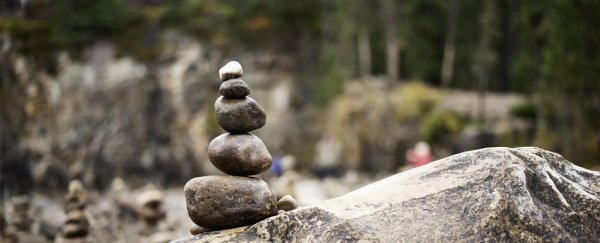They look amazing. All across the internet, you can find them: images of rocks, stones, and pebbles assembled into elaborate, sometimes gravity-defying stacks.
These eye-catching photos, usually framed against stunning natural backdrops, evoke an almost mystical sense of calmness when we see them. But there's a dark side to their contrived wonder, researchers warn.
"It's a global phenomenon … anywhere there [are] rocks, this trend is really taking off," ecologist Nick Clemann from Australia's Arthur Rylah Institute for Environmental Research told ABC News.
"[But] last year we started finding it within the habitat of some of the endangered species we work on. That really started to ring alarm bells."
The problem, as Clemann explains, is something environmentalists have been telling us for years: when people rearrange the rocks they discover in natural landscapes – whether beaches, forests, deserts, or otherwise – those aren't just rocks they're shifting around.
What might seem like a lifeless stone simply lying in the sand or in a riverbed could actually be an integral part of an animal's home environment. By disturbing it for the sake of a photograph, you could be putting creatures and potentially even species at risk.
As opposed to cairns – large, stacked piles of rocks that have been used by humans as monuments and path markers since prehistoric times – the boom in contemporary rock-stacking on social media is purely aesthetic, critics say.
"Rock stacking is a way of quickly making your mark and having an image of it," John Hourston from environmental nonprofit the Blue Planet Society told The New Yorker in 2018.
"People are posting pictures of them on Instagram, saying, 'I've been here and I made this'."
That might seem like a harmless pursuit, but it isn't harmless for species who make their home in rocky enclaves, with the stones providing both shelter from the elements and defence from predators.
"That's what the animals live under and any disturbance to that can mean that the animals are pushed out," Clemann told the ABC.
"Some of the endangered species we work on occur in tiny colonies in little rock outcrops, and a bit of stacking in that area can rapidly mean that colony is no longer viable… [It] destroys the burrow system for those lizards and it can knock those colonies out."
According to Clemann, the problem can present itself even when well-meaning rock-balancers replace the rocks where they originally found them, because even the simple act of removing stones once can be enough to disrupt animals, who may then have to abandon their compromised habitat.
Another issue is soil erosion, where rock removal exposes previously hidden soil, making it more likely to wash away, which diminishes the land that plants can grow in.
The disturbances threaten animals in aquatic environments too, just as they do on land.
"Rock stacking can be detrimental to the sensitive ecosystems of rivers and streams," the website of the Ausable River Association explains.
"Moving rocks from the river displaces important ecosystem structure for fish and aquatic invertebrates. Many [fish] species lay eggs in crevices between rocks, and moving them can result in altered flows, which could wash away the eggs or expose the fry to predators."
While conservationists understand that most people taking rock-stack images have no ill intent and are simply trying to capture beautiful images in the outdoors, they say it's time people woke up to the realities of what their habit might actually be doing to the natural environment they're supposedly celebrating.
"People are doing it with no education of the environment so they don't know what site they're in - whether the site has any wildlife significance or historic significance," Hourston told BBC News in 2018.
"Everything has its place. I think creativity is great and I think getting into the environment is great, but with the growth of social media it's reached a point where everybody's doing it… The first rule of the environment is leave no trace."
